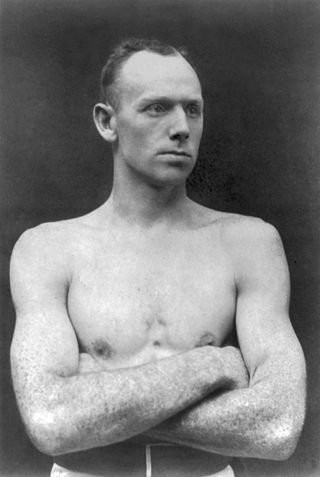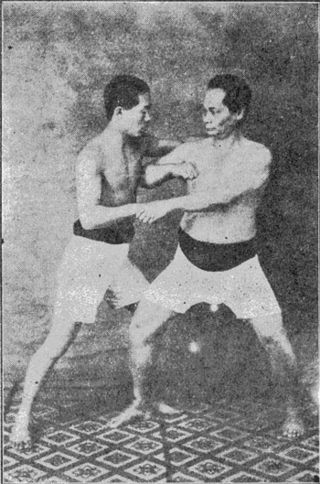This article needs additional citations for verification .(October 2020) |

Boxing training is the training method that boxers use in order to get more fit for their sport.
This article needs additional citations for verification .(October 2020) |

Boxing training is the training method that boxers use in order to get more fit for their sport.
A boxer's training depends largely on the point in their career at which they are situated. If the boxer is just a beginner, a minimal training routine might consist of learning how to hit a heavy bag, a speed bag, or a double end bag (a small bag with a cord on top and bottom connecting it to the floor and ceiling) as well as doing shadowboxing in front of a mirror, skipping rope, calisthenics and jogging every day, as well as an occasional practice bout inside the ring (sparring). Most beginning boxers will spend most of their early careers conditioning and establishing the fundamentals. For the amateur or professional boxer preparing for a competition or bout, however, training is much more stringent. Boxing is widely considered one of the most physically demanding sports in the world.[ citation needed ]
Boxing, like several other fighting sports, categorizes its competitors into weight classes. Some fighters try to take advantage of this by dieting before weigh-in so that they can be bumped down a weight class. In extreme cases, a fighter may forgo solid food before the official weigh-in ceremony, and eat a lot afterward to compensate. In some very extreme cases, boxers have been forced to stop eating solid food up to three days before the weigh-in ceremony, in order to make weight for the fight. Sometimes, if a boxer doesn't make the weight agreed for on the first weight-in, they might go to a sauna or to jog with a jacket to sweat and lose the extra pounds, however this is mainly water that the body holds. After weigh-ins, competitors will in general add on weight before the fight, resulting in them weighing anywhere from 5 to 25 lbs above the weight class. [1]
A boxer will generally try to have the maximum weight possible within the Boxing weight classes they are fighting in, as a good boxer will be able to use their weight to their advantage.
Sparring is "practice fighting" with the aim of training skills and fitness, not to determine a winner. Sparring should always involve use of a mouth-guard, head-guard and groin-guard. [2] Sparring gloves are often more padded than gloves used in actual bouts. Sparring partners sometimes agree to practice particular types of punches or defense moves to focus their training.
Basic boxing training equipment includes:
One of the primary benefits of boxing is that it improves your cardiovascular health. Boxing is a high-intensity workout that gets your heart rate up and increases blood flow throughout your body. Regular boxing sessions can lower your risk of heart disease, stroke, and other cardiovascular problems. [4]

Boxing is a combat sport and martial art. Taking place in a boxing ring, it involves two people – usually wearing protective equipment, such as protective gloves, hand wraps, and mouthguards – throwing punches at each other for a predetermined amount of time.

Kickboxing is a full-contact hybrid martial art and boxing type based on punching and kicking. Kickboxing originated in the 1950s to 1970s. The fight takes place in a boxing ring, normally with boxing gloves, mouth guards, shorts, and bare feet to favor the use of kicks. Kickboxing is practiced for self-defense, general fitness, or for competition. Some styles of kickboxing include: full contact karate, Muay Thai, Japanese kickboxing, Lethwei, Sanda, and Savate.

Martial arts are codified systems and traditions of combat practiced for a number of reasons such as self-defence; military and law enforcement applications; competition; physical, mental, and spiritual development; entertainment; and the preservation of a nation's intangible cultural heritage.

Muay Thai, sometimes referred to as Thai boxing, is a Thai martial art and full-contact combat sport that uses stand-up striking, sweeps, and various clinching techniques. This discipline is known as the "Art of eight limbs", as it is characterised by the combined use of fists, elbows, knees and shins. Muay Thai became widespread internationally in the late 20th to 21st century, when Westernised practitioners from Thailand began competing in kickboxing and mixed-rules matches as well as matches under Muay Thai rules around the world. The professional league is governed by The Professional Boxing Association of Thailand (P.A.T.), sanctioned by The Sports Authority of Thailand (S.A.T.).

Savate, also known as French Boxing or French Foot Fighting, is a French hybrid martial art and full-contact combat sport that combines principles of western boxing with a wide variety of kicking techniques. Unlike kickboxing styles such as Muay Thai, which allow knee and/or shin strikes in competitive bouts, savate involves striking exclusively with one's feet, but participants can nonetheless target any part of the body. The sport is also notable for requiring footwear to be worn by the competitors, as would be expected from individuals fighting in the streets. A male practitioner of savate is called a "tireur" while a female one is a "tireuse".

Robert James Fitzsimmons was a British professional boxer who was the sport's first three-division world champion. He also achieved fame for beating Gentleman Jim Corbett, and he is in The Guinness Book of World Records as the lightest heavyweight champion, weighing just 167 pounds when he won the title. Nicknamed Ruby Robert and The Freckled Wonder, he took pride in his lack of scars and appeared in the ring wearing heavy woollen underwear to conceal the disparity between his trunk and leg-development.

Bare-knuckle boxing is a full-contact combat sport based on punching without any form of padding on the hands. The sport as it is known today originated in 17th-century England and differs from street fighting as it follows an accepted set of rules.

Kumite is one of the three main sections of karate training, along with kata and kihon. Kumite is the part of karate in which a person trains against an adversary.

A strike is a directed, forceful physical attack with either a part of the human body or with a handheld object, intended to cause blunt or penetrating trauma upon an opponent.

A punching bag is a sturdy bag designed to be repeatedly punched. A punching bag is usually cylindrical and filled with various materials of suitable hardness.
The rope-a-dope is a boxing fighting technique in which one contender leans against the ropes of the boxing ring to draw non-injuring offensive punches in an effort to tire their opponent out and, while they are on the ropes, try to execute devastating offensive punches. The rope-a-dope is most famously associated with Muhammad Ali in his October 1974 Rumble in the Jungle match against world heavyweight champion George Foreman in Kinshasa, Zaire.

Boxing gloves are cushioned gloves that fighters wear on their hands during boxing matches and practices. Unlike "fist-load weapons" which were designed as a lethal weapon, modern boxing gloves are non-lethal, designed to protect both the opponent's head and the fighter's hand during a bout. Sparring and other forms of boxing training have their own specialized gloves.

Amateur boxing is the variant of boxing practiced in clubs and associations around the world, at the Olympic Games, Pan American Games and Commonwealth Games, as well as at the collegiate level.

A hand wrap or wrist wrap is a strip of cloth used by boxers to protect the hand and wrist against injuries induced by punching. It is wrapped securely around the wrist, the palm, and the base of the thumb, where it serves to both maintain the alignment of the joints, and to compress and lend strength to the soft tissues of the hand during the impact of a punch.

Throughout the history of gloved boxing styles, techniques and strategies have changed to varying degrees. Ring conditions, promoter demands, teaching techniques, and the influence of successful boxers are some of the reasons styles and strategies have fluctuated.

Ancient Greek boxing dates back to at least the 8th century BC, and was practiced in a variety of social contexts in different Greek city-states. Most extant sources about ancient Greek boxing are fragmentary or legendary, making it difficult to reconstruct the rules, customs and history surrounding this activity in great detail. Still, it is clear that gloved boxing bouts were a significant part of ancient Greek athletic culture throughout the early classical period.
Most rule sets for mixed martial arts (MMA) competitions have evolved since the early days of Vale Tudo. As a result of health, legal, and moral concerns, many different rulesets were created, which give different countries and promotions very different tactics and strategies. Similarly, shoot wrestling organizations, such as Shooto, expanded their rulesets to integrate elements of Vale Tudo into their sport. However, for the most part, fighters accustomed to one rule set can easily acclimate to the others.
White-collar boxing is a form of boxing in which people in white-collar professions train to fight at special events. Most have had no prior boxing experience.

MMA gloves or grappling gloves are small, open-fingered gloves optionally used in mixed martial arts bouts. They usually have around 4–6 oz (110–170 g) of padding and are designed to provide some protection to the person wearing the glove, but leave the fingers available for grappling maneuvers such as clinch fighting and submissions.
Revgear is an American company that encompasses innovative designs, development, manufacturing, worldwide marketing and sales of martial arts supplies, equipment, apparel, and services. The company is headquartered in Van Nuys, California, in the Los Angeles metropolitan area, with over 21 years experience of being a leading supplier of martial arts supplies and equipment to martial arts schools, organizations, and direct consumers.